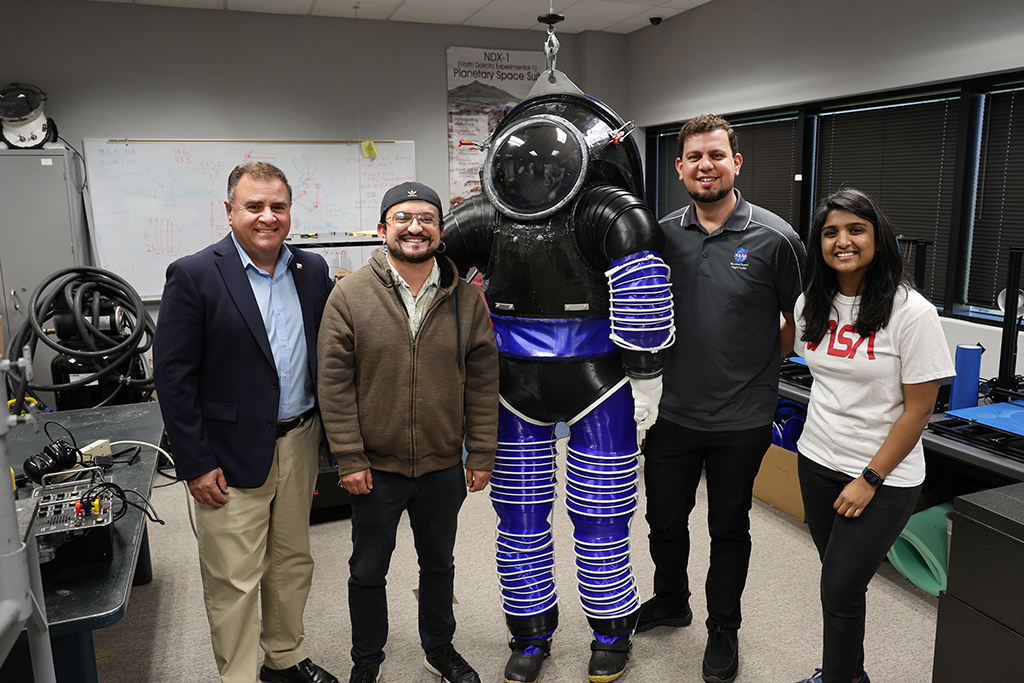26.06.2024
Pablo de León’s patent may allow in-flight manufacture of spacesuits, other materials for Mars missions

Pablo de León, (left) chair of UND’s Department of Space Studies, stands with graduate students David Mateus Jimenez, Jurie Visagie and Pranika Gupta, next to a 3D printed prototype spacesuit. Photo by Joe Banish/UND Today.
Imagine being an astronaut on NASA’s envisioned long-haul flight to Mars, and the unthinkable happens: components on your spacesuit break.
Given that Mars is roughly 140 million miles from Earth, getting replacement parts or a new suit is not an option. But Pablo de León, chair of UND’s Department of Space Studies, has come up with a system to manufacture spacesuits and other parts while on that long journey.
Recently, de León received a patent for his NASA-funded research into 3D printing spacesuits or other objects that are needed in long space voyages. Doing so onboard a spacecraft avoids the supply chain problem of receiving spare parts while far from Earth by bringing the means of manufacture along.
Robert Kraus, dean of Aerospace, congratulated de Léon for his years-long research that culminated in the patent.
“This patent recognizes the original and outstanding work that Dr. de León has put in over the years to develop 3D printing of spacesuits,” said Kraus. “As NASA and others prepare to send people to the moon again and eventually to Mars, longer duration trips will require innovative ways to repair or replace items.”
De León said he and members of his research team welcome the opportunity to develop technology that can help ease the burden of engaging in long-term space travel with a significant number of spare parts.
“My team and I are very pleased to hear we have secured a patent for our work in developing 3D printed spacesuits,” he said. “Our research is ongoing, and we look forward to delivering our results to NASA. One day, astronauts may be wearing spacesuits using technology designed at UND. There are many possibilities for space travel with our technology, and we are very happy to contribute to the future of human spaceflight.”
3D printing is the means of creating an object from a digital design. This is accomplished by using different feedstocks, such as plastic or composite materials, which are laid down layer by layer, and then fused together.
De León said his technology can be used to print an entire spacesuit. The process makes use of special filaments (the feedstock), some rigid, some flexible, depending on the different areas of the body. Joints are typically printed on flexible materials, while other areas, like the torso, are printed in rigid composites. The technology also lends its use to manufacturing other parts, such as 3D printed fluid tanks for pressurized protective systems, among many others.
The filaments used to manufacture the suits can also be produced from elements found in the soil or atmospheric gases of other planets, making the technology particularly useful for a lengthy stay.
The 3D printing process is combined with body scanning technology, which means gloves or boots (which are prone to wear with long-term use), or even an entire suit, can be tailored to a particular person. This also means people who don’t fit the standard suits used today can have ones created for them, or astronauts that have undergone a change to their bodies, can tailor make a suit to accommodate that change.
The idea to 3D print spacesuits was conceived at UND’s Human Spaceflight Lab. The lab has several different missions, among which is to work on designing spacesuits in tandem with NASA. Design work and 3D printing take place at the lab.
De León said this is the first patent he has received. Having a patent means the future of this research is protected, and he can continue to refine and develop the 3D printing process for spacesuits.
Longer duration trips into space may very well come from NASA’s Artemis program, which is a series of missions to return astronauts to the moon to explore its surface, then establish a long-term presence there. NASA then intends to use data collected from lengthy stays on the moon to prepare to send people on a voyage to Mars.

****
>> QUESTIONS OR COMMENTS about the UND LEADS Strategic Plan? Your thoughts are welcome! Please contact Angie Carpenter, UND’s director of Special Student Populations, and/or Ryan Zerr, associate vice president for Strategy & Implementation, the co-chairs of the UND LEADS Implementation Committee.
You also may offer your thoughts by visiting the UND LEADS Strategic Plan home page and clicking on the “Provide your feedback” link that you’ll find there.
Thank you for your support of the UND LEADS Strategic Plan!
Quelle: University of North Dakota
